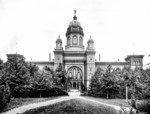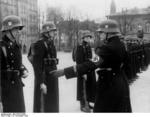Lichterfelde Barracks
| Type | 173 Army Base | |
| Historical Name of Location | Berlin, Germany | |
| Coordinates | 52.431165000, 13.299177000 |
Contributor: Alan Chanter
ww2dbaseConstruction of a prestigious military cadet academy at Lichterfelde, southwest of Berlin, Germany, commenced in September 1873 on a 93-acre site donated to the Prussian Government by the wealthy entrepreneur Johann Wilhelm Carstenn. Over the following decades the academy was attended by a thousand cadets who had graduated from one of several military boarding schools throughout Germany. Among those who would study there were many who would gain fame during the two world wars including Baron Manfred von Richthofen (the Red Baron of World War I fame), General Field Marshal Ervin von Witzleben (remembered for his role in the plot against Adolf Hitler), Kaiser Wilhelm II, President Paul von Hindenburg, Chancellor Franz von Papen and Reichsmarshal Hermann Göring. In 1919 the Treaty of Versailles, stipulating that the academy would be closed, after which the buildings were temporarily taken over as a city-controlled high school with a portion of the facilities housing city police units.
ww2dbaseWith the coming to power of Adolf Hitler, the Nazis cast covetous eyes toward the old academy as an ideal location to house and train its own elites. In 1933, the SA/SS Stabswache "Hermann Göring", a unit that would ultimately provide many of Germany's best paratroopers, moved in. Then after the "Night of the Long Knives", SS General Sepp Dietrich, the corpulent Bavarian and ex-butcher suggested to Hitler that the SS Leibstandarte (Hitler's bodyguard Regiment) should have a setting worthy of them, Hitler agreed and between 1934 and 1938 the elderly academy was extensively renovated into a showpiece modern barracks that would have been greatly envied by troops from other nations more used to sullen barrack blocks. A revolutionary barracks, certainly – but then it was a new sort of army that the architects of Nazism were anxious to create.
ww2dbaseLichterfelde was entered through a main gate on Finckensteinallee, a pleasant tree-lined street. The main gate was dominated by two-heroic-sized statues of German soldiers in greatcoats and coal-scuttle helmets. At each corner of the enormous rectangle which made up Lichterfelde were large dormitory blocks, designated "Adolf Hitler", "Horst Wessel". "Hermann Göring" and "Hindenburg". Within the rectangle were the classrooms and instructional facilities; there was a barracks chapel to which civilians from the Lichterfelde-West suburb were admitted on Sundays.
ww2dbaseAn Olympic-sized pool was constructed for the 1936 Berlin Olympic Games on a site where a gymnasium had once stood. This had a capacity of 1.2 million gallons and measured 50 meters long by 25 meters wide. It exists today as a members only sport club.
ww2dbaseThere was an enormous mess hall which absorbed up to 1,700 men at a single sitting. But still more striking was the dining hall of the officers' home. Even here where they ate and drank and where mess parties were decidedly boisterous, the officers of the Leibstandarte were not allowed to forget their Führer. He gazed down at them from an enormous oil portrait topped by a hand-wrought metal eagle.
ww2dbaseFurnishings in the reception area of the barracks were of the finest oak, the walls inscribed with Nordic runes inlaid in silver, together with their translations. There were magnificent frescoes which lionised the achievements of Germany and, above all, of Hitler's own personal inspiration, Frederick the Great. Lichterfelde had some of the finest stables in the whole of Germany, an underground shooting–range and a garage filled with the most modern equipment. Hitler was almost childishly proud of this magnificent showpiece of his armed SS, and liked nothing better than showing foreign visitors around and regaling them for hours with his own highly individual view of world history and Germany's place in it.
ww2dbaseOn July 4, 1945 General Omar Bradley took command of the American Sector of Berlin from the Soviets and the now abandoned Liebstandarte depot was commandeered by the American garrison and renamed Andrews Barracks. This was in honour of Lieutenant General Frank M. Andrews of the US Army Air Corps who had been tragically killed in an air crash in May 1943. During the period of American occupation the barracks would be home to the US Army Security Forces in Berlin, the military police of Berlin Command, the 298th Army Band, and the 20th (later the 42nd) Engineer Company. The former SS barracks would undergo considerable reconstruction in the post-war years. A new chapel was erected in 1953 and war-damaged buildings were either demolished entirely or restored along more contemporary lines. After the departure of the Americans in 1994 the site was returned to the German state and part of it today houses the German National Archives and a residential hotel.
ww2dbaseSources:
Geoff Walden, Third Reich in Ruins (http://www.thirdreichruins.com/lichterfelde.htm)
Lee Thompson, Andrews Barracks––Witness to a Fearsome History (http://280th-usasa-berlin.com/BA%20002%20070%20Andrews%20Barracks%20-%20Nazi.html)
Rupert Butler, The Black Angels – The story of the Waffen-SS (Hamlyn Paperbacks, 1978)
Last Major Update: Feb 2016
Lichterfelde Barracks Mapa Interativo
Photographs
 |  |  |  |
Você gostou deste artigo ou achou este artigo útil? Se sim, considere nos apoiar no Patreon. Qualquer valor já vai ajudar! Obrigado. Por favor, ajude-nos a divulgar o site: Fique atualizado com WW2DB: |

Berlin, Germany
Latitude-Longitude:
52.4312, 13.2992
- » 1,181 biografias
- » 337 eventos
- » 45,111 entradas na linha do tempo
- » 1,246 navios
- » 350 modelos de aeronaves
- » 207 modelos de veículos
- » 376 modelos de armas
- » 123 documentos históricos
- » 261 instalações
- » 470 eventos
- » 28,471 fotos
- » 365 mapas
Captain Henry P. Jim Crowe, Guadalcanal, 13 Jan 1943
Por favor, considere nos apoiar no Patreon. Mesmo R$1 por mês já faz uma grande diferença. Obrigado!
Ou, por favor, nos apoie adquirindo alguns produtos do WW2DB na TeeSpring. Obrigado!